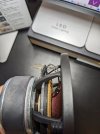Thank you, all.
Things are getting weirder and weirder. I thought it might be a good idea to swap the woofers to see if the one previously under suspicion of being faulty would play fine in the other speaker, which it did. As I opened the other speaker, I noticed that the insides of the woofer area looked pretty much the same, including the soldering on the black cable. So it must have been by design and the previous owner probably did not tinker with it. The only major difference is a more neatly looking voice coil. This gave me a nagging thought that I should check out the first speaker, as maybe simply unplugging and plugging the woofer back in could have an impact. And the woofer is back in action which I'm more confused than happy about.
So, either he woofer played fine for the first few minutes in my posession, then something caused it to lose the connection, or it arrived in a non-working state which was fixed by unplugging and plugging it back in. Could the amp have anything to do with the former? Does either scenario have a plausible scientific explanation?
Just in case, when I initially identified that the woofer was silent, I confirmed it with a second amplifier, so any issues with bass reproduction on the amplifier side or wrong/loose connections are unlikely.
EDIT: Is the re-soldering job still desirable or should I just start enjoying them?

